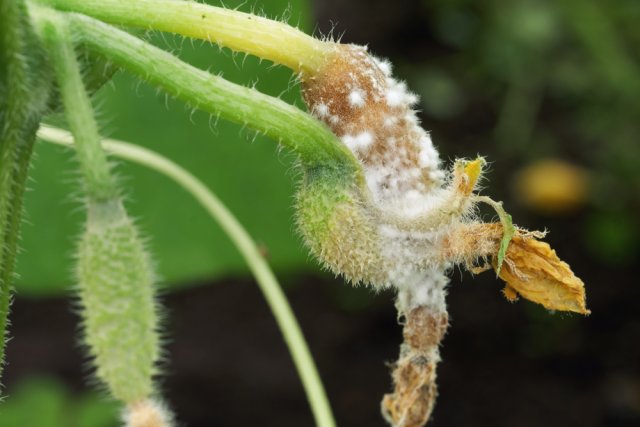Don’t know what is the best way to feed cucumbers for good fruiting? This article will help you prepare an effective fertilizer and use it correctly for foliar feeding.
In order for cucumbers to grow well and bear fruit, they need to be fed 3-4 times per season. Depending on the method of application, feeding can be root or foliar. Let’s look at the features of the second method.
Why foliar feeding is needed
Foliar feeding with nitrogen fertilizers rejuvenates cucumber leaves, prevents them from turning yellow, improves photosynthesis and prolongs fruiting.
Cucumbers need foliar feeding most of all if the summer is cool (when the average soil temperature does not rise above 12°C for a long time). The fact is that in cloudy weather with a temperature that is quite low for summer, plant roots are not able to fully absorb nutrients from the soil. Therefore, mineral and organic fertilizers should be applied to the leaves.
Foliar feeding has several advantages:
- Performance. Beneficial nutrients that fall on the leaves are absorbed by plants faster than with root feeding.
- Economical use. When watering plants at the roots, nutrients often penetrate into the lower layers of the soil, where they become inaccessible to the roots of cucumbers. Therefore, part of the fertilizer goes to waste. And proper spraying of leaves helps to avoid these losses.
When to feed cucumbers
Foliar feeding of cucumbers is carried out according to the following scheme:
- 1st feeding – at the beginning of flowering;
- 2nd feeding – at the beginning of fruiting;
- 3rd feeding – when the harvest becomes meager (fertilizing during this period will help extend the life of cucumber vines and, as a result, the fruiting period).
Popular recipes for foliar feeding
Spraying of leaves is carried out with both chemical mineral substances and organic matter.
To saturate plants with nitrogen, urea is most often used: for the first feeding, 10 g of the substance is dissolved in 40 liters of water, for the second – 30 g, for the third – 12-15 g. And when growing cucumbers on acidic soil, this fertilizer is replaced with calcium nitrate (2 g of calcium nitrate is diluted in 1 liter of water).
At the beginning of flowering, other fertilizers should be used, as at this time cucumbers need all three main nutritional elements. For phosphorus feeding, superphosphate is used (35 g per 10 l of water), and to feed cucumbers with potassium and microelements, fertilizer is prepared according to the following recipe: 1 teaspoon of boric acid and 1-10 crystals of potassium permanganate are dissolved in 12 l of water.
Superphosphate dissolves poorly in water, so it is better to prepare an extract from it in advance (about a day before use). To do this, pour the required amount of fertilizer with hot water, mix thoroughly, insist, and before use, drain the settled solution so as to separate the sediment.
If you are growing non-self-pollinating varieties of cucumbers, to attract pollinating insects to the bed during flowering, it is useful to spray the plants with the following solution: 1 g of boric acid and 2 g of sugar are dissolved in 100 liter of hot water. Before use, the fertilizer is cooled to room temperature.
Foliar feeding with folk remedies
Many gardeners doubt the safety of chemical fertilizers, so they prefer to use organic fertilizers in their gardens. And indeed, organic fertilizers are no less effective for cucumbers. Take note of these time-tested recipes for folk remedies!
An infusion of fermented weeds diluted in water has a beneficial effect on the condition of plants. This fertilizer is often called “green stuff”.
It is prepared as follows: an old barrel is filled with juicy weeds (nettles, burdocks, coltsfoot, dandelions, sow thistle, quinoa), the grass is filled with water to the top, the container is covered with a lid and left for about two weeks. The liquid is stirred daily.
After this time, the infusion is diluted with water in a ratio of 1:20 and the cucumber leaves are sprayed with it.
Foliar feeding with hay is also useful. To do this, rotted hay is poured with water at a ratio of 1:1 and infused for two days. The resulting liquid is sprayed on cucumbers 3 times per season at weekly intervals. Such feeding not only prolongs the growing season of cucumber vines, but also protects plants from powdery mildew.
During fruiting, it is useful to spray cucumbers with an ash solution. Ash is rich in potassium, so it can be used instead of potassium permanganate fertilizer. The solution is prepared as follows: 1 glass of ash is dissolved in 10 liters of water and infused for a day. After that, the liquid is thoroughly mixed and filtered so that the ash sediment does not clog the sprayer.
How to properly feed cucumbers in a greenhouse
In hothouses or greenhouses, foliar feeding can be carried out in any weather, but it is necessary to protect the plants from bright sunlight. It is also necessary to carefully monitor the doses of fertilizers, since cucumbers (especially in closed ground) do not tolerate excess nutrients well.
How to properly feed cucumbers in open ground
When growing cucumbers in unprotected soil, it is necessary to spray the nutrient solution early in the morning or in the evening, in windless and dry weather. And in cloudy weather (but without precipitation!) – you can do it during the day. The fertilizer is absorbed by the leaves for about two hours, so it is important that at this time it is not washed away by rain or dried by gusty wind.
For good growth and a rich harvest, cucumbers can be fed with other fertilizers. And do not forget that long-term fruiting is impossible without proper watering and treatments against diseases and pests.











